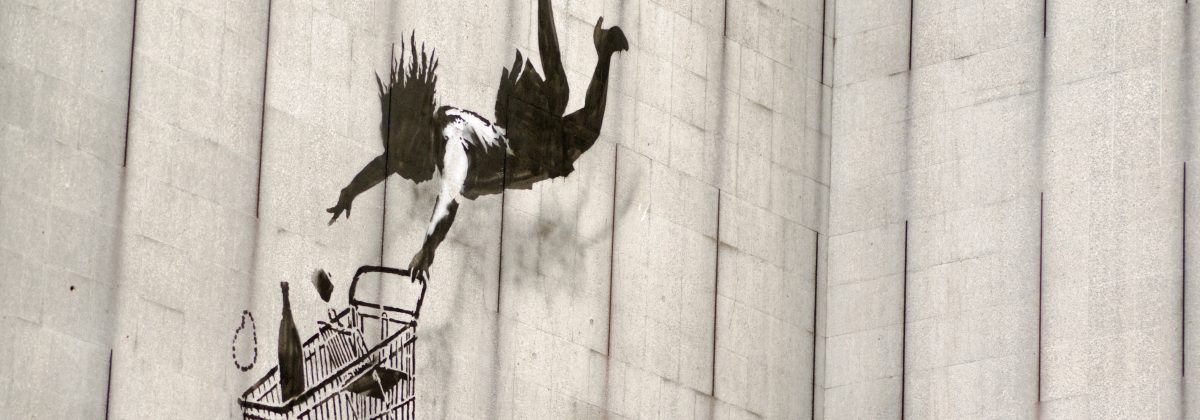

December 18, 2019
2017 saw a seismic change in the UK’s artistic tastes – a national poll showed that Constable’s Hay Wain is no longer the Nation’s favourite art work; instead this venerable icon of Britishness has been supplanted by Banksy’s Girl with Balloon which now tops the Nation’s list of favourites. This image which shows a little girl staring wistfully at her red heart-shaped balloon as it floats away out of her reach, became an instant classic when it was first published in 2004 and has remained a firm favourite with the public ever since.
This change in taste away from traditional art towards Urban and Street art has been developing for the past ten years and has resulted in a very significant strengthening of the commercial Urban market and in particular that of Banksy which is now one of the most buoyant and bullish markets of any contemporary artist.
Banksy’s market is divided into two very distinct sectors – his print market and the market for original works on canvas. Both these sectors have seen phenomenal growth in prices over the last ten years and specifically in the past five years – way beyond that seen by almost any other UK artist. This is a clear testament to the popularity of the anti-establishment Banksy, although it is debatable how long he can be considered anti-establishment when major works by him can now sell for upwards of a million dollars. What is interesting about the growth of the Banksy market is that it goes against all recognised rules governing upward growth.
One of the main factors influencing this growth is normally a limited supply of work, which creates a desire in the market to acquire an artist’s work, which in turn leads to higher prices. With Banksy’s this is simply not the case as he is hugely prolific and the size of his editions in both his print and canvas productions are high. It is not uncommon for his prints to be produced in editions as large as 350 or even 500 – the prints are also often produced as both a signed and unsigned edition. Even his canvases are often produced in editions of 25, alongside unique pieces.
This is normally a recipe for commercial disaster; however, as in the case with his mentor Damien Hirst, this high volume of work, coupled with the intense notoriety surrounding him, has actually been a positive factor in his growth as it has resulted in huge trading activity. High volumes of trading, whether through galleries, auction houses or private sales, creates both a real and perceived momentum in an artist’s market which attracts attention from collectors, which further feeds interest in the artist. The fact that Banksy’s works were also so affordable when they were first sold has helped to fuel his market as it has created a very large and disparate collector base from the start spread over all backgrounds. This is highly unusual in the general art market where a more limited supply of an artist’s work and higher entry-level price points restrict the collector base. It must be remembered that many of Banksy’s early prints were sold for £20-£50 and originals sold for a couple of hundred pounds. Due to this high volume of early trading, steady and continued increases in value were seen almost immediately. Prints bought in 2002 for £50 were being sold three years later for low thousands – thus fanning a frenzy to collect the artist’s work which has never abated.
A case in point is the nation’s favourite image, Girl with Balloon – this print was produced in 2004 in both a signed and unsigned edition. Both were sold at the time for under £100 (the signed costing more). The signed edition of 150 prints currently retails in galleries for close to £200,000, and the unsigned edition of 600 sells for £65,000. Not a bad investment in 13 years. It is easy to see why collectors are drawn to Banksy like bees to honey.
In terms of insurances, art professionals and savvy collectors follow the market very closely and are fully aware of the rises in prices, however, the average collector who perhaps bought a print five years ago might not have an idea of the huge appreciation that has occurred in the value of his work in recent years and will, as a result, find themselves in the position of being significantly under insured. As a general rule, insurance valuations are recommended every 5 years, however in the case of Banksy this is totally inadequate – it is strongly recommended that under current circumstances all collectors should reassess their collections every 18 months in order to stay fully covered. In the case of many of Banksy’s iconic works, these are increasing by 10% a year – how long this growth can continue is unknown, but collectors should react to it as long as it does.
See below examples of prices changes since 2014 – only 3 years ago!
This article was written by Ben Hanley, Modern and Contemporary Art Specialist at Doerr Valuations.
Ben is one of their many specialists able to provide art valuation and advisory services for both companies and private individuals – see their website for more information.
Flint Private Clients provide superlative home and motor insurance for high net worth individuals; ours is an holistic approach to supply comprehensive, quality cover, that represents excellent value for money.
Regular valuations of jewellery, art, antiques and other contents is important in the battle against underinsurance. Call Flint Private Clients on 0208 426 3649 for advice on ANY aspect of your high value cover.